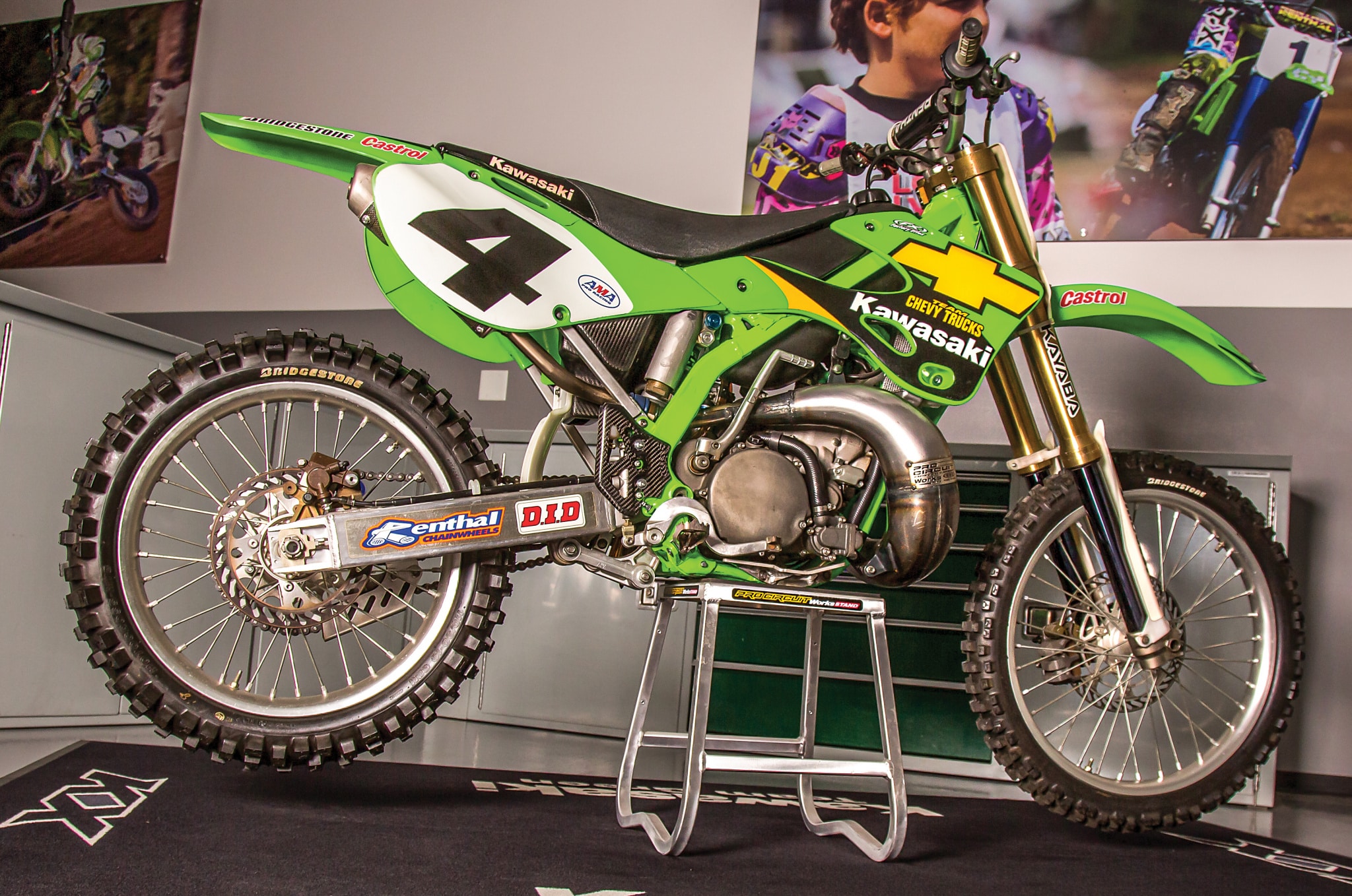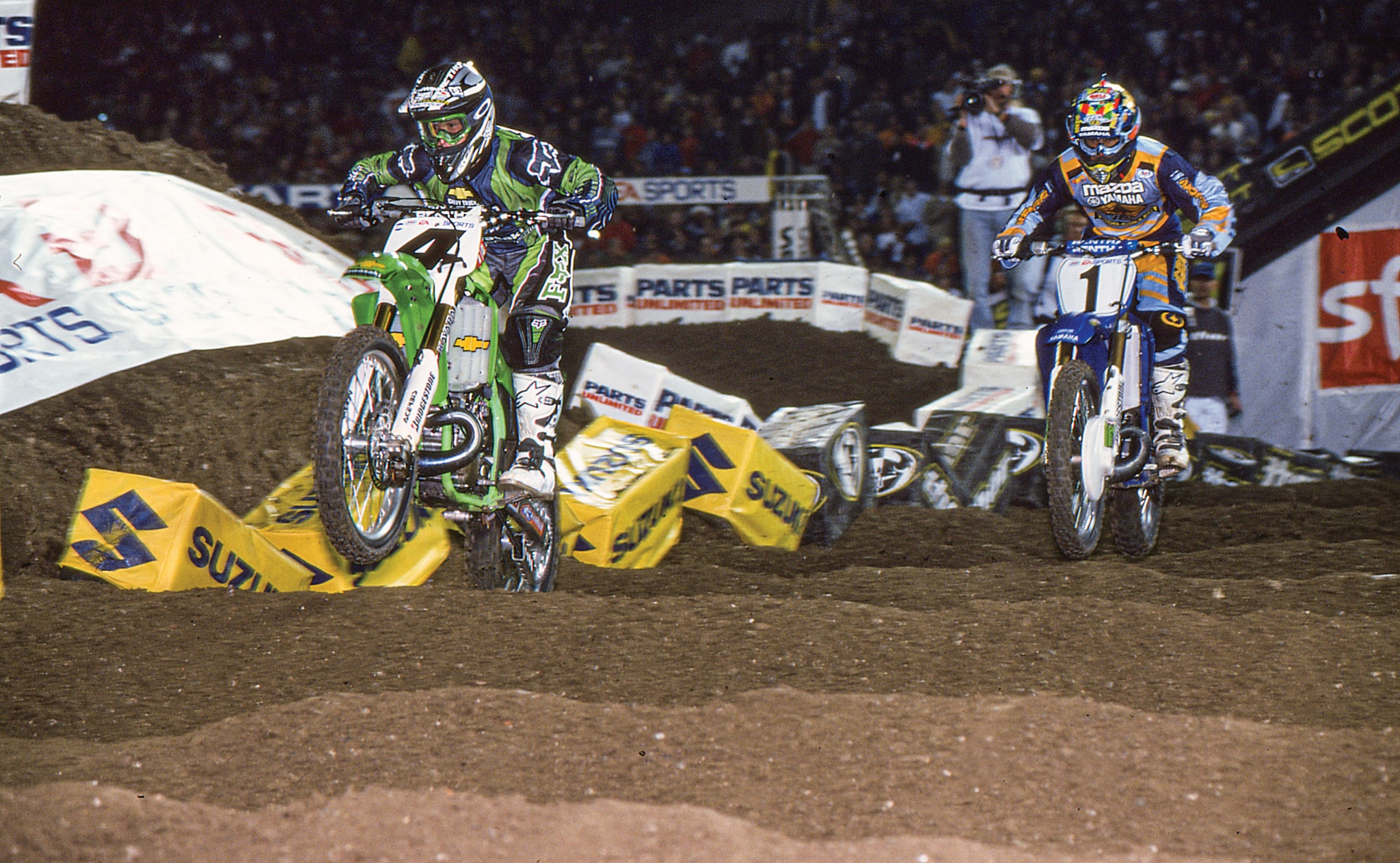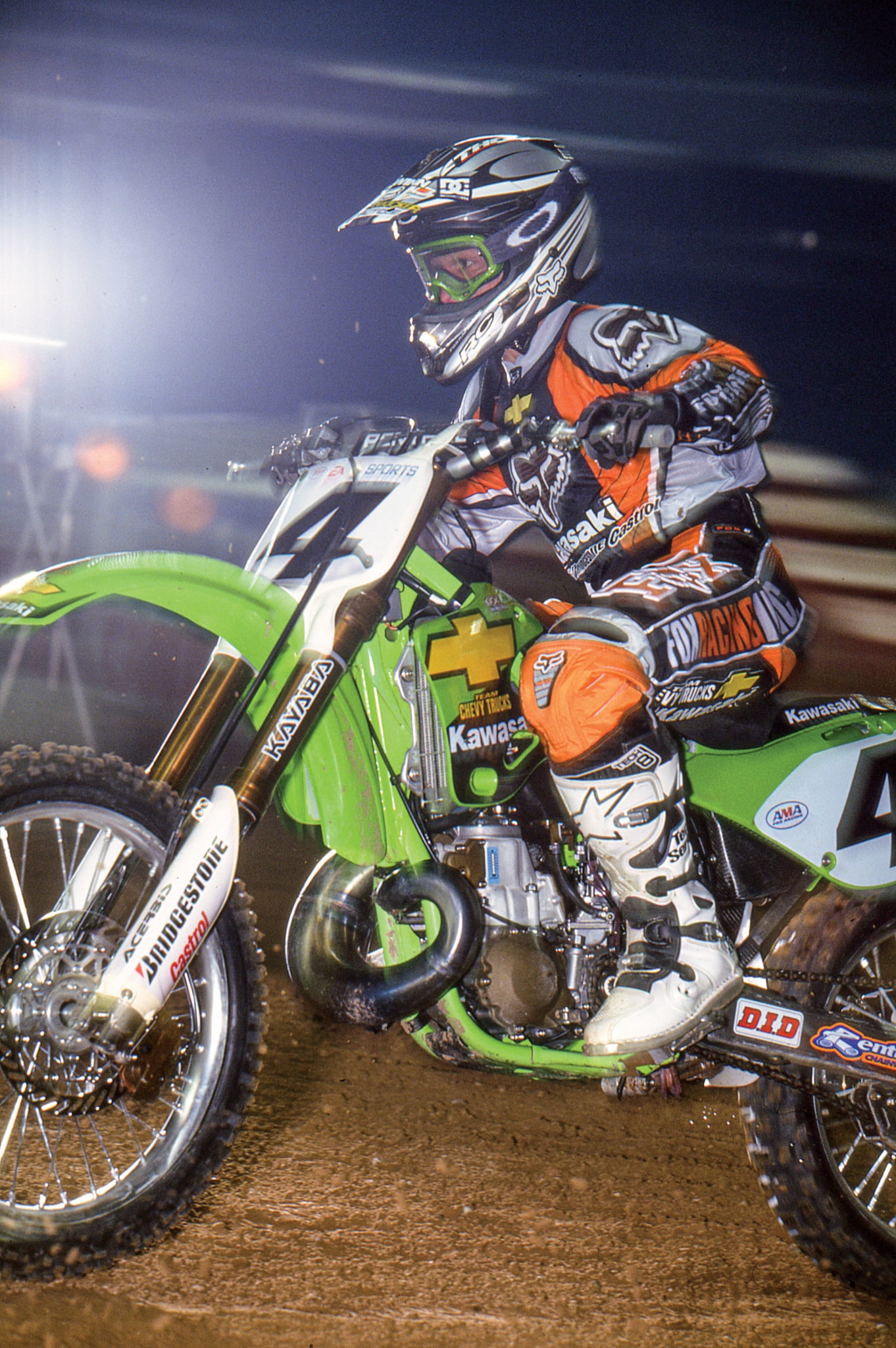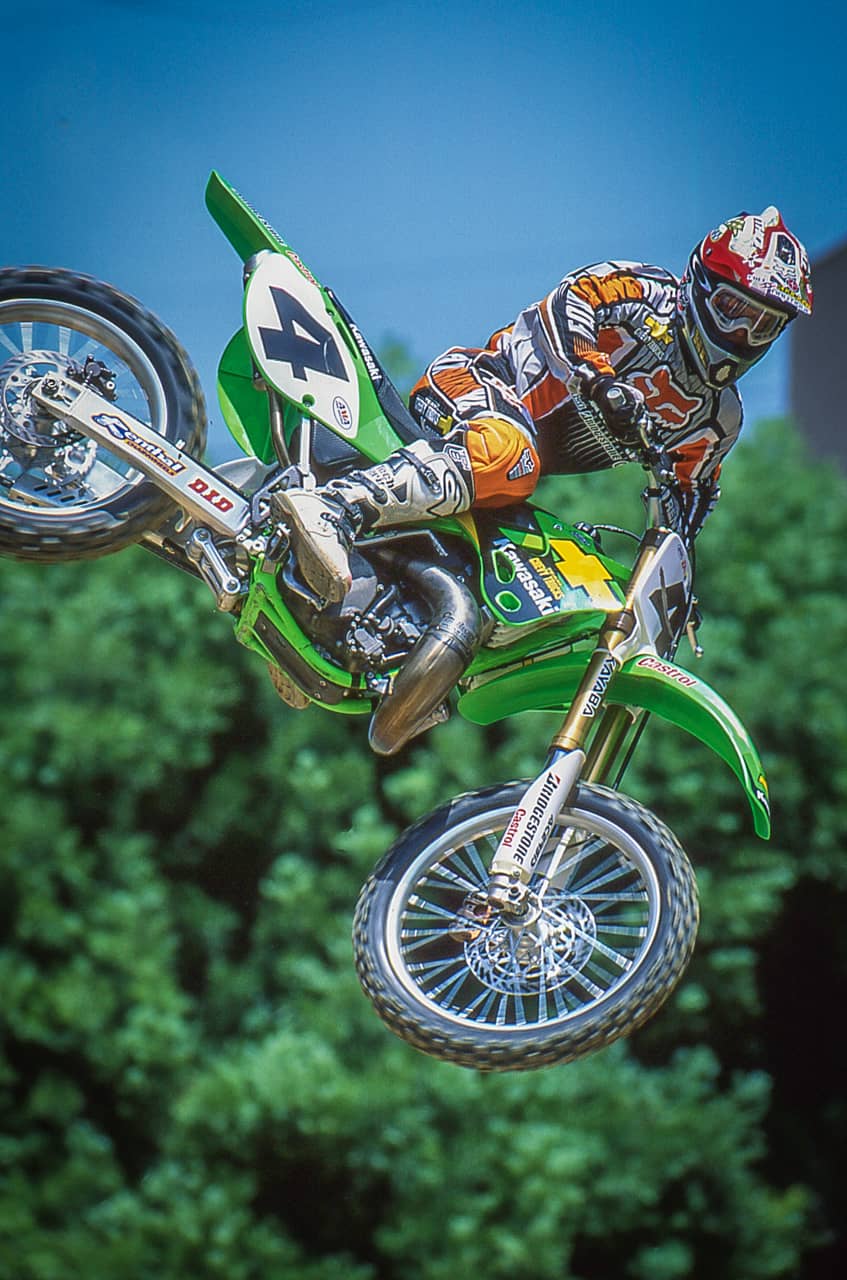THE BIKE THAT ENDED THE REIGN OF THE KING OF SUPERCROSS
 The 2001 Kawasaki KX250 helped Ricky Carmichael win his first premier-class AMA Supercross title. The most prestigious Championship in our sport.
The 2001 Kawasaki KX250 helped Ricky Carmichael win his first premier-class AMA Supercross title. The most prestigious Championship in our sport.
In the early 2000s, Jeremy McGrath was the King of Supercross. He was virtually unbeatable, winning seven Supercross Championships in eight years. He won 72 Supercross main events. Team Kawasaki knew that someday, someone was going to beat “Supermac,” and they had banked everything on a short, stocky, red-headed kid from Florida named Ricky Carmichael. Ricky was no slouch. Leading up to the 2001 season, Ricky had won three straight 125 National Motocross Championships (1997-1999), the 1998 AMA 125 East Supercross crown and the 2000 AMA 250 National Championship. But, Ricky was unsure of his future in the 250 Supercross Championship—not just because the omnipotent Jeremy McGrath was coming off his seventh Supercross title, but because 250 Supercross was another animal. Ricky Carmichael doubted that he had what it took in terms of race-savvy, physical prowess or leg length to win the Supercross Championship.
JEREMY WAS THE MAN TO BEAT, AND KAWASAKI UNDERSTOOD THAT RICKY WASN’T JELLING WITH THE 2000 KX250.
Kawasaki sat Ricky Carmichael down, and they worked on a plan that would get both of them what they wanted. The first step was to build Ricky a bike that could take down the King of Supercross. This is the story of what went into building Ricky a bike that could do the job—and believe us, it was no easy task.
MXA met with the 2001 Chevy Trucks Kawasaki race team manager Bruce Stjernstrom to detail one of the most iconic race bikes in AMA history.
Ricky Carmichael had some glimpses of greatness in the 2000 Supercross season with Kawasaki, winning the Daytona Supercross and making the podium six times in the 16-race series on the KX250. But, Jeremy won 10 main events and was on the podium in all but two of the 16 races. Jeremy was the man to beat, and Kawasaki understood that Ricky wasn’t jelling with the 2000 KX250. After the 2000 season concluded, Ricky, Bruce and Norm Bigelow met at Kawasaki’s SoCal headquarters. They asked Ricky what he would need to succeed in Supercross. Ricky was very clear about what he wanted. “We gotta lower the back end of this bike, because the seat keeps hitting me in the butt and knocking me off the footpegs,” said Ricky. Kawasaki immediately went to work on solving Ricky’s issues.
KAWASAKI HAD LOADS OF VIDEOS, AND THEY WATCHED McGRATH’S TECHNIQUE AND BIKE TO SEE HOW HIS BIKE WORKED AND WHY HE WAS SO GOOD. SOME OF THE CHANGES THE TEAM MADE WERE DIRECTLY LINKED TO WATCHING THE VIDEO OF McGRATH.
To that end, Kawasaki hired Craig Decker as a test rider. Decker and Ricky rode a lot together until Craig felt that he could emulate Ricky’s riding style. The funny thing is that Craig Decker is 6 feet tall and RC is 5-foot-6. During the 2000 AMA National Motocross season, while Ricky and Team Chevy Trucks Kawasaki were at the races, Norm and Decker went to work on building a competitive Supercross bike for Ricky to race in 2001.
At the end of the motocross season (which Ricky won), the team asked Ricky to come to California to test what they had built. After the first day, Carmichael told the team, “I can win on this thing.” The team jokingly mentioned the post-season U.S. Open in Las Vegas as a trial run for the bike. One thing led to another, and the team went racing. Ricky was dominant and showed that he was a lot closer to being a contender in 2001. There was one caveat—Jeremy McGrath wasn’t at the U.S. Open, and Jeremy was the one guy that Kawasaki was targeting.
More changes were made from the U.S. Open to Anaheim 1. Carmichael felt extremely confident heading to the races. At the 2001 Anaheim season opener, Ricky finished third, but Jeremy won. The following weekend in San Diego, Ricky won and McGrath was third. The third race, back at Anaheim Stadium, McGrath won again, but Ricky was second. The fourth race was in Phoenix, and Ricky won with Jeremy second. The real test would come at Anaheim 3, because Jeremy McGrath won eight times in Anaheim. The 2001 Anaheim 3 was the turning point for Carmichael. He won, which boosted his confidence. From this point on, Ricky and the team knew they could win! The following week he finished first and had to come from the back of the field. Towards the end of the race, he diced head to head with McGrath for the win. He went on to win the next 13 races in a row! He won 14 of 16 Supercross races that season.
 Kawasaki showed Ricky videos of Jeremy McGrath’s YZ250 going through the whoops in 2001. In 2002, when Ricky moved to Honda, they showed him videos of Chad Reed’s YZ250 going through the whoops.
Kawasaki showed Ricky videos of Jeremy McGrath’s YZ250 going through the whoops in 2001. In 2002, when Ricky moved to Honda, they showed him videos of Chad Reed’s YZ250 going through the whoops.
Ricky Carmichael won the 2001 Supercross Championship, and the team felt like they had put a good program together. Kawasaki had loads of videos, and they watched McGrath’s technique and bike to see how his bike worked and why he was so good. Some of the changes the team made were directly linked to watching the videos of McGrath. Bruce recalled going to the races and saying, “Ricky’s going to win unless we screw it up.” The goal was to make sure the bike was perfect for Ricky every race. It wasn’t just McGrath who was riding well. Windham, Larocco, Tortelli and Vuillemin were all riding extremely well. It was a stacked field.
Ricky matured as a rider that season. He hired Aldon Baker during the outdoor season and put his head down to be the fittest of them all. Because Ricky isn’t a very big rider, he had to be stronger. Improving his strength allowed him to maneuver the bike the way he wanted to. That and Kawasaki’s improvements led to victories on the racetrack.
JAPAN TOLD THE TEAM THAT THE 1998 FRAME HAD SOME SMALL DIFFERENCE IN COMPARISON TO THE 1999 THROUGH 2001 FRAMES. MOST NOTABLY, THE SUSPENSION HAD A LOWER RIDE HEIGHT THAN THE NEWER FRAMES.
As the bike was going through its testing and development, Kawasaki had a lot of discussions with the Japanese engineers at KHI (Kawasaki Heavy Industries). Japan told the team that the 1998 frame had some small difference in comparison to the 1999 through 2001 frames. Most notably, the suspension positions on the 1998 frame had a lower ride height than the newer frames. Craig Decker tested the 1998 KX250 frame and was positive that it was a better setup for Ricky. The team also used longer pull rods to lower the ride height even more, and the shock height was shortened while the subframe was cut down 5mm. By the time the team was done, Ricky could sit on the bike with his feet almost flat on the ground!
However, these frame changes led to some complications with other areas of the bike. First of all, the seat didn’t fit well at all. The team had to make a new seat base. The foam in the seat had to be cut as well. Norm would cut the foam with an electric carving knife before the races. There was almost no foam in the thing. Bruce said that Ricky would take the seat off the race bike and take it with him back to Florida. He would ride on the seat all week and bring it back the following weekend to the races. He liked the way it felt. It was all about getting the rear of the bike lower. Additionally, Ricky ran a whopping 112mm of sag!
With the bike high in the front and ultra low in the rear, it made it much easier for Ricky to get through the whoops. He was always good in the turns and felt as fast as the next guy in that area. But, he believed that dealing with the whoops and rougher areas of the track put him at a disadvantage. As for Ricky Carmichael’s rear-suspension setup, the team ran a lot of rebound damping. It would go down and stay down! Once the seat, sub-frame and shorter shock were all mounted up, there was no room for the airbox. Kawasaki had to have a carbon fiber airbox especially molded to fit in the space that they had left themselves. Bruce told MXA that of all the modifications they made for any specific Kawasaki team rider over the years, Ricky’s 2001 KX250 had the most customizations. And, when Ricky moved to Team Honda, it wasn’t long before the red bike was lowered and the handlebars rolled back.
 Ricky’s 2001 KX250 engine pumped out (at the time) a whopping 47 ponies.
Ricky’s 2001 KX250 engine pumped out (at the time) a whopping 47 ponies.
Kawasaki felt that the engine package was really good. They didn’t spend a lot of time worrying about the power. They did get some works SR parts from Japan, one of which was a TPS carburetor. It had a programmable CDI, and the team could map it to get the power in the right place for Ricky’s riding style. There was some concern that they might be pushing the AMA rules on what an AMA-legal “production” bike required. Kawasaki talked to the AMA about every modification that they were doing because they wanted to make sure that Ricky’s 2001 KX250 was approved and there was no risk of a protest or penalty. Titanium fasteners littered the bike and helped drop the weight to only 2 pounds above the legal AMA weight limit. The team used magnesium side cases and triple clamps (with a 22mm offset). Bruce told us that Ricky’s factory KX250 produced 47 horsepower‚ big numbers for 21 years ago, but the team’s 2022 KX450 is pumping out well over 60 horsepower.
AS FOR RICKY CARMICHAEL’S REAR-SUSPENSION SETUP, THE TEAM RAN A LOT OF REBOUND DAMPING. IT WOULD GO DOWN AND STAY DOWN!
Chevy Trucks was the team’s primary sponsor at the time. Kawasaki worked closely with Chevrolet on the look of the bike. Originally, Chevy’s marketing department gave the team a logo from the automotive side. You could hardly see it on the bike, and that was a problem. The Kawasaki team didn’t want to lose the Chevy sponsorship by not getting them enough exposure, so Kawasaki looked at tons of color samples to get an idea for a new logo design. The team came up with a bright yellow and orange logo with a black outline. Chevy said, “That’s not our color.” Kawasaki explained they were aware of that but told Chevy’s marketing team that it was much easier to see than the current logo on the bike. It took a while to get the approval from a giant corporation like Chevrolet, but, funny enough, Chevy eventually adopted the Kawasaki-designed logo into some of their other sports sponsorships. Additionally, Factory Effex, Kawasaki’s graphic supplier, was worried that if they sold aftermarket Kawasaki graphics with the Chevy logo on it, Ford and Dodge truck owners wouldn’t buy team graphics from them. That concern faded when the Chevy-logo team graphics became their best-selling kits of 2001. And, even today in 2022, you see the Chevy Trucks graphics on vintage two-stroke builds across the country. It became iconic.
 In 2001, Ricky only lost two SX races that season. Both were to McGrath.
In 2001, Ricky only lost two SX races that season. Both were to McGrath.
Looking back at the rise of Ricky, Kawasaki knew that Ricky had his doubts about how good he could be at Supercross. He knew he was good at motocross but didn’t think that Supercross favored short riders. Kawasaki told Ricky that they believed in him and knew he could win. The team felt that if he got stronger he would instantly improve indoors. That is where Aldon Baker entered the motocross arena and made a name for himself.
When the 2002 Kawasaki KX250 was introduced, it benefited from a lot of the things Ricky worked on in 2001, and the team was able to translate it into the next-generation Kawasaki KX250. But, Ricky Carmichael wasn’t there to take advantage of the new production bikes. He had jumped ship to Team Honda. Team Kawasaki was now focusing on its next rising star, James Stewart. The plan was to have a four-stroke ready in 2005, but the team had to wait. The Kawasaki KX250 two-stroke had a lot of success before being put out to pasture. Jeff Emig, Jeff Ward, James Stewart and Ricky Carmichael are just some of the KX250 notables.
 Back in the early 2000s Bridgestone tires were the tire of choice for the factory riders.
Back in the early 2000s Bridgestone tires were the tire of choice for the factory riders.
Bruce told MXA that when he looks back on the era of Ricky Carmichael on the KX250, he is amazed at how good Ricky was. Bruce said that Ricky was “a rider who was super dedicated and would do anything to win. He absolutely hated losing. He did great things for Kawasaki.”
Ricky moved to Honda the following year and then to Suzuki before calling it a career. He became the “GOAT” largely because of his championship dominance on the KX250 in 2001 against the King of Supercross — Jeremy McGrath.







Comments are closed.